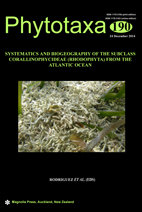Abstract
Coralline algae (Corallinophycidae, Rhodophyta) are primarily characterized by the impregnation of calcium carbonate (calcite) in their cell walls. To determine the systematic position of genera and species, researchers are increasingly combining anatomical studies with comparisons of DNA sequences. In the present study we have described the main representatives of the genus Lithophyllum in intertidal and subtidal habitats from the southern coast of Brazil based on anatomical studies, supported by molecular markers. Analyses were conducted on specimens collected from five sites along the coast of southern Brazil. Anatomical studies were carried out by light and scanning electron microscopy. Molecular studies were based on DNA barcoding markers (cox1; UPA) and SSU rDNA. Using comparative anatomical features, corroborated by the molecular data, we identified two taxonomic entities from the Brazilian coast: Lithophyllum margaritae, and we propose the new species Lithophyllum atlanticum.

